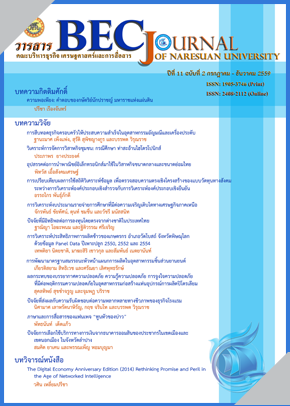การเปรียบเทียบผลการใช้สถิติวิเคราะห์ข้อมูล เพื่อตรวจสอบความตรงเชิงโครงสร้างของแบบวัดทุนทางสังคม ระหว่างการวิเคราะห์องค์ประกอบเชิงสำรวจกับการวิเคราะห์องค์ประกอบเชิงยืนยัน
Main Article Content
บทคัดย่อ
การวิจัยนี้มีวัตถุประสงค์เปรียบเทียบผลการใช้สถิติวิเคราะห์องค์ประกอบ เพื่อตรวจสอบความตรงเชิงโครงสร้างของแบบวัดทุนทางสังคม ระหว่างการวิเคราะห์องค์ประกอบเชิงสำรวจและการวิเคราะห์องค์ประกอบเชิงยืนยัน กลุ่มตัวอย่าง คือ สมาชิกของเครือข่ายรวบรวมข้าวโพด จังหวัดพิษณุโลก จำนวนกลุ่มละ 299 คน จำนวน 2 กลุ่ม (จากจำนวนประชากรทั้งหมด 750 โดยกลุ่ม EFA ตอบกลับมา 284 คน ในขณะที่กลุ่ม CFA ตอบกลับ 296 คน) ผลการวิเคราะห์พบว่า การวิเคราะห์องค์ประกอบเชิงสำรวจ (Exploratory Factor Analysis: EFA) ได้องค์ประกอบจำนวน 2 องค์ประกอบ (KMO= 0.789) แต่ตัวบ่งชี้ในองค์ประกอบไม่แตกต่างจากโมเดลตามทฤษฎี ที่ได้จากการวิเคราะห์องค์ประกอบเชิงยืนยัน (Confirmatory Factor Analysis: CFA) ได้องค์ประกอบจำนวน 2 องค์ประกอบ ได้แก่ เครือข่าย (Network) และความเชื่อใจ (Trust) และตัวบ่งชี้ในองค์ประกอบตรงกับโมเดลตามทฤษฎี โดยมีดัชนีวัดความกลมกลืน ดังนี้ ค่าไคว์สแควร์ = 44.232 ค่า df = 35 P = 0.136 ค่า CMIN/DF = 1.264 ค่าดัชนี GFI = 0.970 AGFI = 0.922, CFI = 0.994 TLI = 0.987 และ RMSEA = 0.035 ดังนั้นการวิจัยครั้งนี้การวิเคราะห์ EFA ไม่สามารถยืนยันโมเดลตามทฤษฎีเหมือนการวิเคราะห์ CFA ดังนั้นการตรวจสอบความตรงเชิงโครงสร้างจึงควรใช้ CFA และแบบวัดรูปแบบทุนทางสังคมที่ได้จากการวิเคราะห์ CFA สามารถนำไปใช้วัดรูปแบบทุนทางสังคมกับกลุ่มตัวอย่างได้อย่างเหมาะสม อย่างไรก็ตาม การเลือกใช้การวิเคราะห์องค์ประกอบแบบสำรวจหรือแบบยืนยัน หรือแบบคู่ขนานไปด้วยกัน
The Comparison of the Use of Statistics Analysis in Testing Construct Validity of Social Capital: An Exploratory Factor Analysis (EFA) and A Confirmatory Factor Analysis (CFA)
This research aims to compare the use of factor analysis in testing construct validity of social capital between a Confirm Factor Analysis (CFA) and an Exploratory Factor Analysis (EFA). The samples were corn agriculturist community of practices (CoPs) in Phitsanulok province, 2 group of 299 persons each (Population= 750 persons, EFA respondents 284 persons, and CFA respondents = 296 persons). The result from the EFA shows 2 elements of Social capital (KMO= 0.789) while the indicator elements are not different from theoretical models. The result from the Confirmatory Factor Analysis (CFA) indicates 2 elements of the social capital: Network and Trust. The findings are supported by the theoretical models. The model fit indies are CMIN (Chi-square) = 44.232, Degree of Freedom= 35, CMIN/df (Relative Chi-square) = 1.264, GFI=0.970, AGFI= 0.922, CFI= 0.994, TLI= 0.987 and RMSEA= 0.035. In this way, EFA cannot confirm the model based on such theory as CFA. For this reason, Construct Validity should be tested by CFA and valid social capital measurement model fits appropriately. Nevertheless, choices are provided of using parallel/separate factor analysis method. (EFA and/or CFA).
Article Details
เอกสารอ้างอิง
อรรถไกร พันธุ์ภักดี. (2559). การเปรียบเทียบผลการใช้สถิติวิเคราะห์ข้อมูล เพื่อตรวจสอบความตรงเชิงโครงสร้างของแบบวัดทุนทางสังคม ระหว่างการวิเคราะห์องค์ประกอบเชิงสำรวจกับการวิเคราะห์องค์ประกอบเชิงยืนยัน. วารสารบริหารธุรกิจ เศรษฐศาสตร์และการสื่อสาร, 11(2), 46-61.


